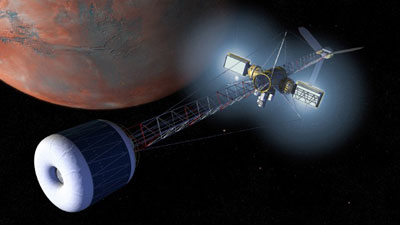Operation Public Eyeby Gregory Anderson
|
| Reporters can and do follow armies onto battlefields, but they cannot yet follow astronauts into space. |
The problem up to now has been that nobody except NASA and its Russian counterpart has been able to reach that frontier, so the American people have relied on NASA’s openness to allow them to judge NASA’s abilities. That problem is now on the verge of being subject to a solution.
After all, NASA’s spaceships are built by private aerospace corporations, so the stumbling block is not that private industry lacked the technology. Rather, private corporations have been unable to build and fly Mars missions at a profit. With the advent of small probes using high technology, however, it’s now possible to build and fly spacecraft on a budget similar to a Hollywood blockbuster movie, about $200 million. With another couple decades before the first manned mission to Mars begins its ramp up to launch, the cost of flying a small but very capable spacecraft to the Red Planet should drop still more. That would put it within the budget of a consortium of news organizations, if not quite within reach of any one.
The difference between a movie and a spaceflight is putting money into a profitable venture on the one hand and a venture that may not turn a profit on the other. Movie producers are fairly sure they will make their money back, even if they have to wait years for overseas sales and video rentals to do it. For-profit space missions are another matter entirely. A news consortium may, of course, decide to pursue such a Mars mission as a loss leader, simply as a public and historical service, especially if tax write-offs for consortium members were available.
There may be a better way for a private group to get at least some of its investment back, however. A craft designed to carry a television camera to Mars and aim the camera at the correct area at the correct time to catch the glow of the engine of the Mars ship as it put its crew into Martian orbit could be relatively simple. The capability to relay radio signals properly, for example, probably could be easily added to the basic design. That could be important financially.
For the early manned missions to be seen as successful, the surface crew will need to explore large areas of Mars, ranging far from their base. To do so and remain in constant communications with the base and with Earth will require a system of communication relay satellites in orbit around Mars. Line-of-sight radio contact between the explorers and their base would severely limit the area that could be covered, both because explorations beyond the local horizon of the base would be impossible, and because the rough, boulder-littered surface of Mars would continually break contact.
| For a bigger investment, the news group could send and operate its own surface camera. A camera on wheels would be even more useful: perhaps such a rover would be called News Hound. |
Relay satellites are the solution. Three satellites in the same equatorial orbit one hundred twenty degrees apart could be enough; three more in a polar orbit should virtually guarantee at least one relay satellite would be available to surface explorers at all times. If the news probe could fill the role of a relay satellite after taking its historic video, surely that would be a service for which the consortium should be compensated. Such an arrangement would also bring the news group directly into planning the manned mission—a reporter’s dream of access.
A working television camera in orbit could also prove very useful to mission controllers and astronomers. Depending on the capability of the camera, studies of Deimos and Phobos, Mars’ two tiny moons, could be conducted while humans were exploring the planet’s surface at first hand, to name but one possibility. NASA—assuming NASA is the lead agency in the effort—will no doubt deploy its own television cameras on the surface to thoroughly document the crew’s exploration. For a bigger investment, however, the news group could send and operate its own surface camera, controlled from Earth with the help of the relay satellite. A camera on wheels would be even more useful: perhaps such a rover would be called News Hound.
One flaw in Star Trek is that Starfleet is out there waging wars and deciding the future of the galaxy, and no one is there to tell people back home any of it. That’s not how free, democratic societies operate. Going to Mars with “Operation Public Eye” could be the first step toward bringing a truly independent press with us on our journey to the stars.
